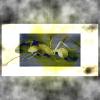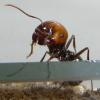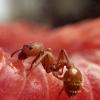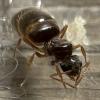I wish I had some easy way of marking ants! I can't even tell how old my Vero workers are. I want to label them by generation (well maybe at the granularity of "early 2025" and "late 2025") and see who does what where. That's why it's easier to see learning occurring in smaller, younger colonies. [EDIT: Mayyybe a special plexiglass nest cover with tiny holes, through which a very tiny pen can be inserted to mark ants???]
So I know I've told this story elsewhere, but I will relate it here. It's my other favorite ant/colony learning and transformation story:
Camponotus fragilis, also founded 2019. Young colony in a mini-hearth. I hooked it up via tubing to a separate larger outworld and put in live fruit flies there. The foragers apparently thought the flies were enemy ants! They sprayed them to death and immediately dumped them in the trash pile, like how you would treat an enemy ant, not food. This was very frustrating because I wanted them to EAT the fruit flies.
I finally put some fruit flies in the mini-hearth's small outworld on top. Then the forager ants had to drag their defeated foes through the nest. THAT was the key. The younger nursery ants recognized the fruit flies as food. I don't know how the memo went out, but VERY soon after the foragers brought dead fruit flies through the nest, suddenly the fruit flies became "food." They were no longer dumped in the trash - they were taken home.
Now, fast forward to later when the colony was upgraded to a Fortress (note: they currently reside in a Nucleus but I want to move them to a Laby), I saw some really cool behavior with live fruit flies. It LOOKED so organized and well-delegated. Fruit flies wandered all over the outworld, some high up on the wall. One ant ran back and forth on the outworld wall, knocking down fruit flies. Other ants below killed them and left them lying around. Other ants hauled them into the nest. I can't remember, but there may have been nest-internal ants then ferrying the corpses further (as with the Veromessor). There was a little "shop" set up in the nest to process the fruit flies.
Unfortunately I stopped giving live fruit flies because I started getting mite problems, buuuuut I really miss seeing that very complex system of independently acting parts, somehow coming together to form one incredible fruit fly collection and processing machine.
ETA: I have kind of the opposite, also in 2019 I believe. A dead-end colony of Camponotus sansabeanus that did NOT learn. I loved the big, angry queen. ANY sign of ANY bug, and her scared nanitics would run to hide in her skirts (well you get the idea) and she would storm out, mandibles gnashing, and go up to the mealworm or whatever bug piece I gave them. She would spray, and spray again, then, satisfied she had killed the invader, would march back to her nest. Her nanitics would crowd around her. You could imagine their proud but sadly confused conversation: "I have killed the enemy! We are safe!" "All hail Her Majesty, the Warrior Queen!" ...and meanwhile they never recognized the insects as food. I vaguely remember trying all sorts of protein but ... nope, everything was treated as The Enemy. They did not survive and I'm still especially sad about the Mad Queen.
Edited by OhNoNotAgain, March 25 2025 - 10:51 PM.
Formiculture Journals::
Veromessor pergandei, andrei; Novomessor cockerelli
Camponotus fragilis; also separate journal: Camponotus sansabeanus (inactive), vicinus, laevigatus/quercicola
Liometopum occidentale; Prenolepis imparis; Myrmecocystus mexicanus (inactive)
Pogonomyrmex subnitidus and californicus (inactive)
Tetramorium sp.
Termites: Zootermopsis angusticollis
Isopods: A. gestroi, granulatum, kluugi, maculatum, vulgare; C. murina; P. hoffmannseggi, P. haasi, P. ornatus; V. parvus
Spoods: Phidippus sp.


















